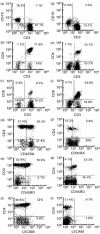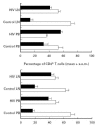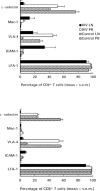Phenotypic and functional characterization of lymphocytes derived from normal and HIV-1-infected human lymph nodes
- PMID: 10403921
- PMCID: PMC1905490
- DOI: 10.1046/j.1365-2249.1999.00942.x
Phenotypic and functional characterization of lymphocytes derived from normal and HIV-1-infected human lymph nodes
Abstract
Lymph nodes are the major site of cell-to-cell transmission and replication of HIV-1. Trafficking of CD4+ T lymphocytes into lymph nodes provides a continual supply of susceptible target lymphocytes, and conversely, recruitment of CD8+ T lymphocytes may be critical for the host response that attempts to control HIV-1 replication. The present study was undertaken as no detailed assessment of lymphocyte subpopulations in HIV-1-infected lymph nodes has previously been reported. Peripheral blood and single-cell suspensions prepared from lymph nodes of patients with HIV-1 and control subjects were analysed using three-colour flow cytometry. Approximately 80% of the lymphocytes in control lymph nodes were CD3+ T lymphocytes, of which over 65% were CD4+. The majority of the CD4+ and CD8+ T lymphocytes obtained from both lymph nodes and blood of control subjects were immunologically naive (CD45RA+). By contrast, in HIV-1-infected patients there was a significant reduction in the proportion of CD4+ T lymphocytes and an expansion of the CD8+ T lymphocyte subset in both lymph nodes and peripheral blood. Furthermore, a high proportion of these T lymphocytes displayed a marker for immunological memory (CD45RO+). T lymphocytes derived from HIV-1-infected lymph nodes also showed altered expression of the adhesion molecules, L-selectin and very late antigen-4 (VLA-4), but not leucocyte function-associated antigen-1 (LFA-1). In an in vitro adhesion assay, lymphocytes from HIV-1-infected nodes were significantly more adhesive than control lymphocytes on fibronectin, as well as recombinant human intercellular adhesion molecule-1 (ICAM-1) and vascular cell adhesion molecule-1 (VCAM-1) substrates. This combination of altered lymphocyte subpopulations in the HIV-1-infected lymph nodes, as well as enhanced adhesion phenotype and function, suggests that T lymphocyte traffic to lymph nodes in HIV disease may be an important determinant of pathogenesis.
Figures




Similar articles
-
Expression of adhesion molecules and CD28 on T lymphocytes during human immunodeficiency virus infection.Clin Diagn Lab Immunol. 1998 Jul;5(4):583-7. doi: 10.1128/CDLI.5.4.583-587.1998. Clin Diagn Lab Immunol. 1998. PMID: 9665971 Free PMC article.
-
HIV type 1-reactive chemokine-producing CD8+ and CD4+ cells expanded from infected lymph nodes.AIDS Res Hum Retroviruses. 1998 May 20;14(8):643-9. doi: 10.1089/aid.1998.14.643. AIDS Res Hum Retroviruses. 1998. PMID: 9618075
-
Lymphocyte populations in human lymph nodes. Alterations in CD4+ CD25+ T regulatory cell phenotype and T-cell receptor Vbeta repertoire.Immunology. 2003 Nov;110(3):304-12. doi: 10.1046/j.1365-2567.2003.01742.x. Immunology. 2003. PMID: 14632657 Free PMC article.
-
How does HIV cause depletion of CD4 lymphocytes? A mechanism involving virus signaling through its cellular receptors.Curr Mol Med. 2001 Nov;1(5):545-50. doi: 10.2174/1566524013363320. Curr Mol Med. 2001. PMID: 11899230 Review.
-
Apoptosis in HIV-1 Infection.Behring Inst Mitt. 1996 Oct;(97):220-31. Behring Inst Mitt. 1996. PMID: 8950478 Review.
Cited by
-
The majority of HIV type 1 DNA in circulating CD4+ T lymphocytes is present in non-gut-homing resting memory CD4+ T cells.AIDS Res Hum Retroviruses. 2013 Oct;29(10):1330-9. doi: 10.1089/AID.2012.0351. AIDS Res Hum Retroviruses. 2013. PMID: 23971972 Free PMC article.
-
Elevation and persistence of CD8 T-cells in HIV infection: the Achilles heel in the ART era.J Int AIDS Soc. 2016 Mar 3;19(1):20697. doi: 10.7448/IAS.19.1.20697. eCollection 2016. J Int AIDS Soc. 2016. PMID: 26945343 Free PMC article. Review.
-
Viral dissemination and immune activation modulate antiretroviral drug levels in lymph nodes of SIV-infected rhesus macaques.Front Immunol. 2023 Sep 18;14:1213455. doi: 10.3389/fimmu.2023.1213455. eCollection 2023. Front Immunol. 2023. PMID: 37790938 Free PMC article.
-
Enhanced anti-HIV efficacy of indinavir after inclusion in CD4-targeted lipid nanoparticles.J Acquir Immune Defic Syndr. 2012 Dec 1;61(4):417-24. doi: 10.1097/QAI.0b013e3182653c1f. J Acquir Immune Defic Syndr. 2012. PMID: 22743598 Free PMC article.
-
Decreased CXCR3+ CD8 T cells in advanced human immunodeficiency virus infection suggest that a homing defect contributes to cytotoxic T-lymphocyte dysfunction.J Virol. 2007 Aug;81(16):8439-50. doi: 10.1128/JVI.00199-07. Epub 2007 Jun 6. J Virol. 2007. PMID: 17553894 Free PMC article.
References
-
- Young AJ, Hay JB, Mackay CR. Lymphocyte recirculation and life span in vivo. Curr Topics Microbiol Immunol. 1993;184:161–73. - PubMed
-
- Mackay CR, Marson WL, Dudler L. Altered patterns of T cell migration through lymph nodes and skin following antigen challenge. Eur J Immunol. 1992;22:2205–10. - PubMed
Publication types
MeSH terms
Substances
LinkOut - more resources
Full Text Sources
Other Literature Sources
Medical
Research Materials
Miscellaneous

